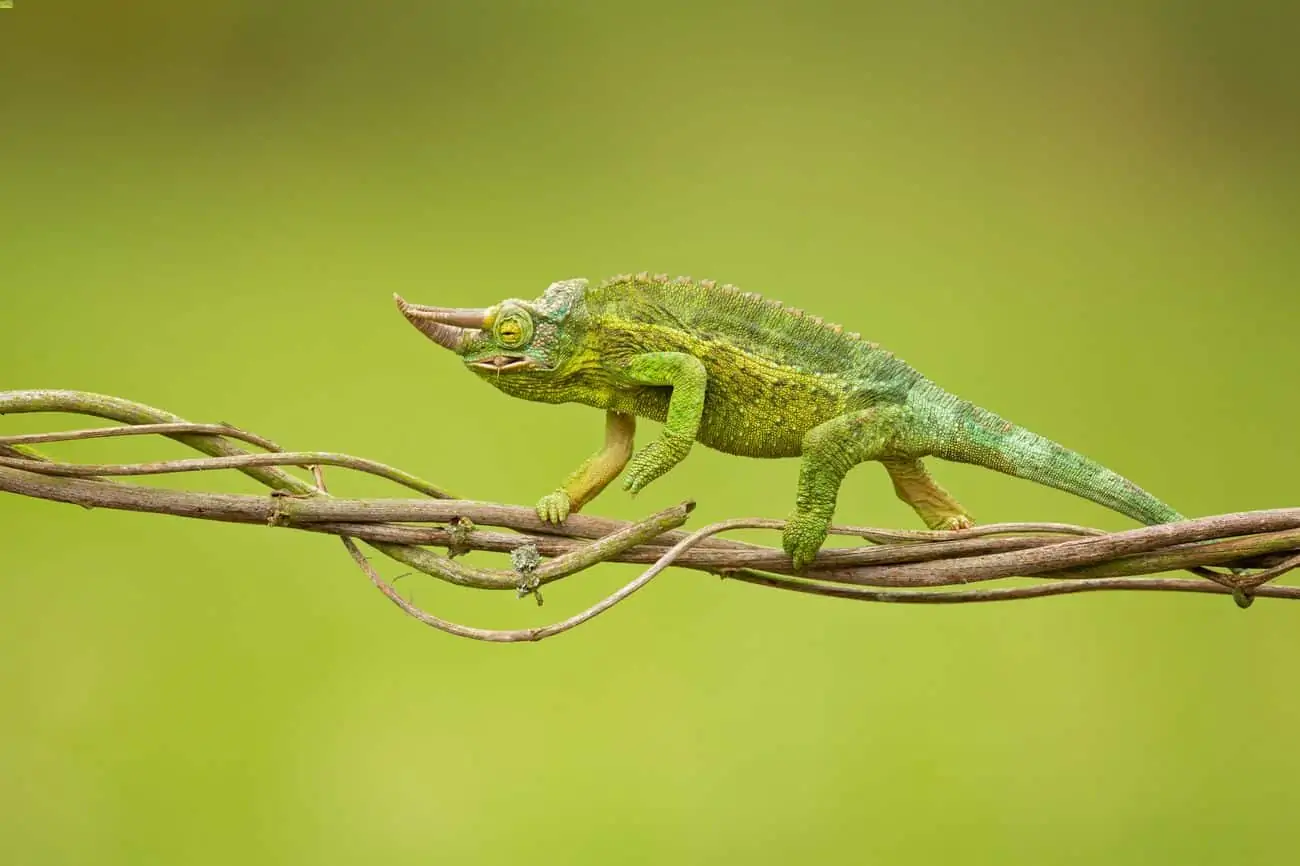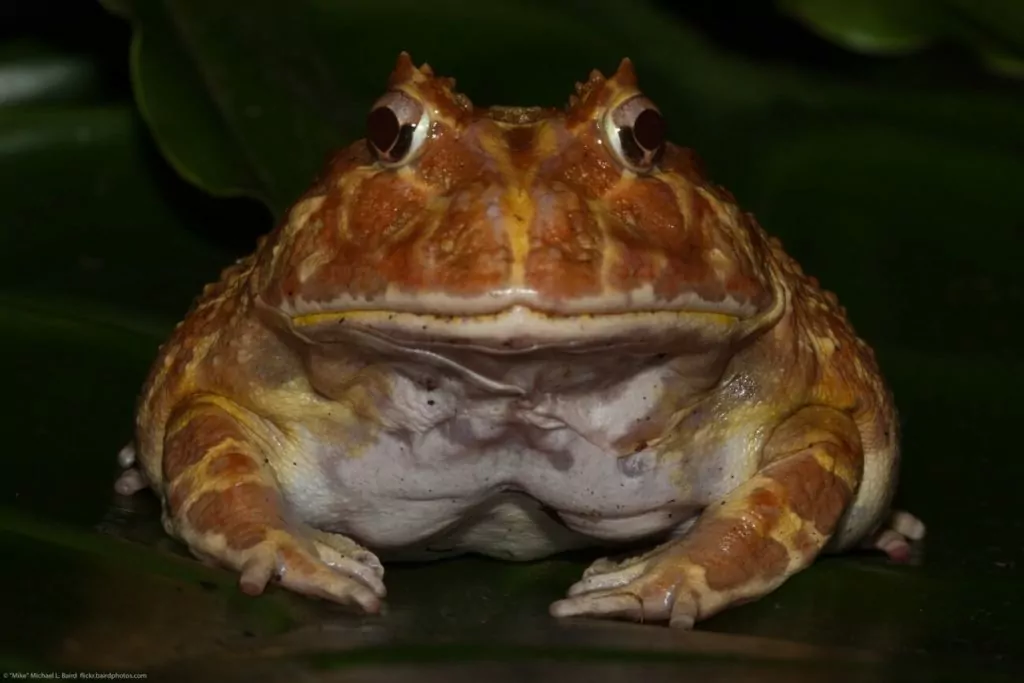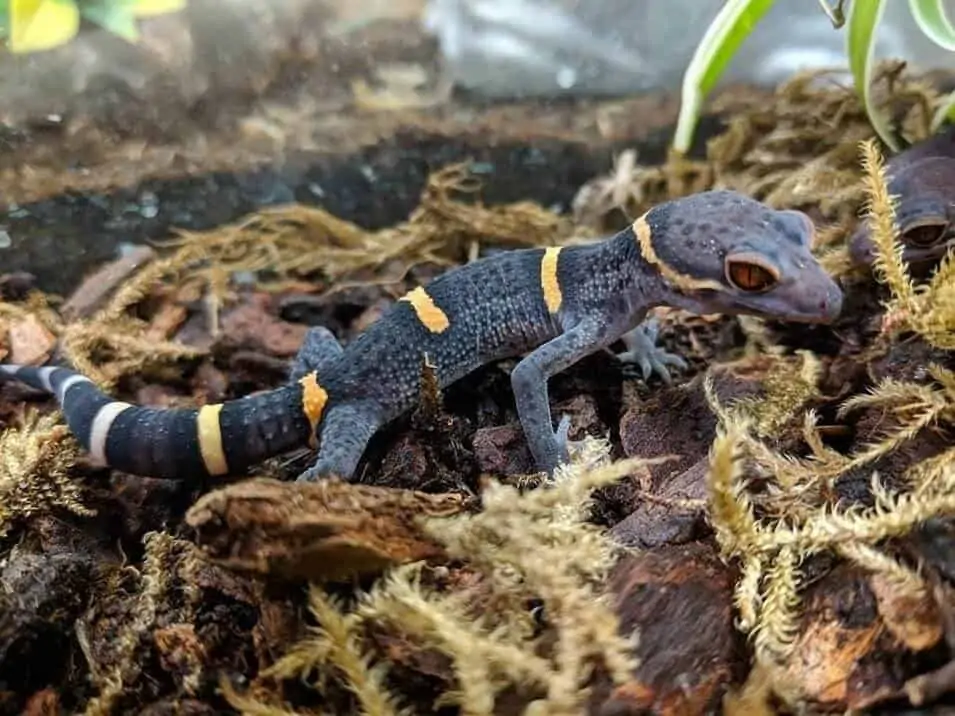If you’re looking for an extremely unique and mellow pet reptile, the Jackson’s chameleon might be the animal for you!
These interesting critters stand out from the pack and can be very rewarding to own. But be warned, they do require a bit of extra attention!
In this guide we’ll cover all the fundamentals of Jackson’s chameleon care. By the time you’re finished reading, you’ll know how to help this reptile thrive (and if they’re right for you).
Table of Contents
Species Summary
Jackson’s chameleon (Trioceros jacksonii) is also known as Jackson’s horned chameleon. This gorgeous and popular chameleon can be found in the mountainous areas near Nairobi, Kenya.
Before buying a Jackson’s chameleon, make sure that you are getting one from a responsible and trusted source. Check the chameleon for signs of sickness like skin issues, lethargy or eye issues.
Because this type of chameleon requires a pretty detailed set-up, we recommend that you have a fairly advanced level of reptile husbandry experience before you attempt to care for one of these beautiful and unique creatures.
Appearance & Colors
Some of the most striking features of the Jackson’s chameleon are the male’s set of three rostral horns and his parietal crest. Due to dimorphism, females do not have these physical characteristics.

Both male and females are a lovely, bright green color, and both can display markings of yellow and blue. They may change their color slightly due to mood or environmental conditions.
Aside from that, this species has a pretty typical chameleon body structure with prehensile tails and eyes that can focus and rotate separately.
Jackson’s Chameleon Lifespan
The typical Jackson’s chameleon lifespan is around ten years (sometimes longer). However, this lifespan is only attainable by providing them with excellent care over time.
Expert Tip: For breeding females this lifespan is often noticeably shorter. Females that have been used for breeding usually only have a lifespan of four to five years.
Average Size
The average size of a Jackson’s chameleon is between eight and ten inches long for males, and seven to eight inches in length for females.
The main factors that influence the size of this species are the conditions in which they were born, and overall care. If you purchase these reptiles from a reliable seller and provide them with a great home, they’ll probably grow to their full potential size!
Jackson’s Chameleon Care
Jackon’s chameleon care requires a fair amount of advanced knowledge and commitment. There’s a price to pay for owning such an interesting and unique pet reptile!
Before you take on the responsibility of caring for one of these amazing pets, make sure that you are prepared for the time and attention you’ll need to devote to its care and wellbeing.
Jackson’s chameleons require a pretty large enclosure, and the temperature, lighting and humidity have to be constantly monitored. You’ll also need to provide appropriate, nutritious food, and the enclosure has to be kept immaculately clean.
Enclosure Size
Jackson’s chameleons should never be kept in a glass enclosure. If your chameleon sees itself in the glass, it may think there is another chameleon in its territory, and this will cause lots of stress.
Also, it can get its tongue stuck on the glass!
The best kind of enclosure is one with screened sides. This allows for plenty of air to circulate throughout the enclosure. It’s good to use the biggest enclosure you have room for, but using one of at least 2 x 2 x 3 feet is fine.
Expert Tip: If you plan on owning more than one of these reptiles, it’s best to give each one its own enclosure. This will ensure the physical and mental health of both Jackson’s chameleons.
General Habitat Setup
When creating the perfect habitat for your Jackson’s chameleon, the goal should be to make the living space as natural and comfortable as possible. This means that you’ll want to include places where they can bask, climb and hide.
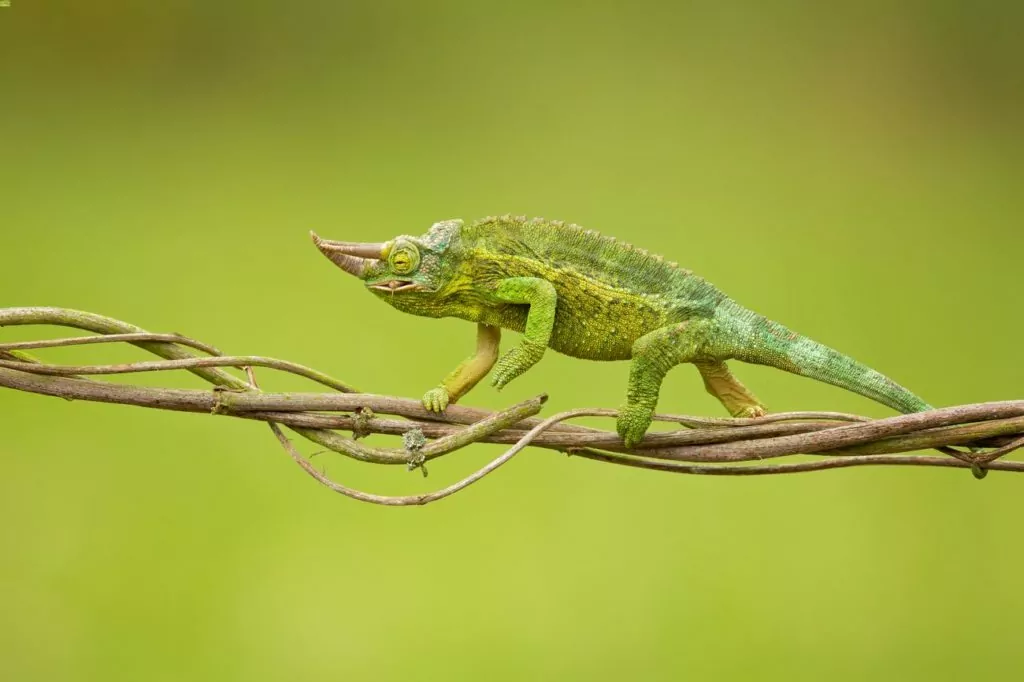
Their enclosure is not going to require any kind of complicated substrate. Newspapers, paper towels or a reptile carpet will do fine, and these simple items make cleaning up a breeze.
Placing lots of living or artificial plants in the enclosure also has several important benefits. Plants provide places to climb and hide, and they help retain moisture for drinking and humidity.
Putting plants into the enclosure is really simple because you don’t even need to plant them! Plants can stay in their pots, and this makes it easy when it’s time to clean the enclosure. You want to choose tall growing plants because the foliage needs to reach the very top of the enclosure. Pothos, dracaena and hibiscus are good options.
Expert Tip: Always make sure that any plants, whether live ones or artificial, are safe and non-toxic.
In addition to plants, your Jackson’s chameleon will appreciate having plenty of branches placed at different levels throughout the enclosure.
Temperature & Lighting
Temperature and lighting are pretty key elements of proper Jackson’s chameleon care.
Your pet is going to need some help regulating its body temperature, and this is why creating a temperature gradient is so important. This may sound complicated, but it’s actually quite easy.
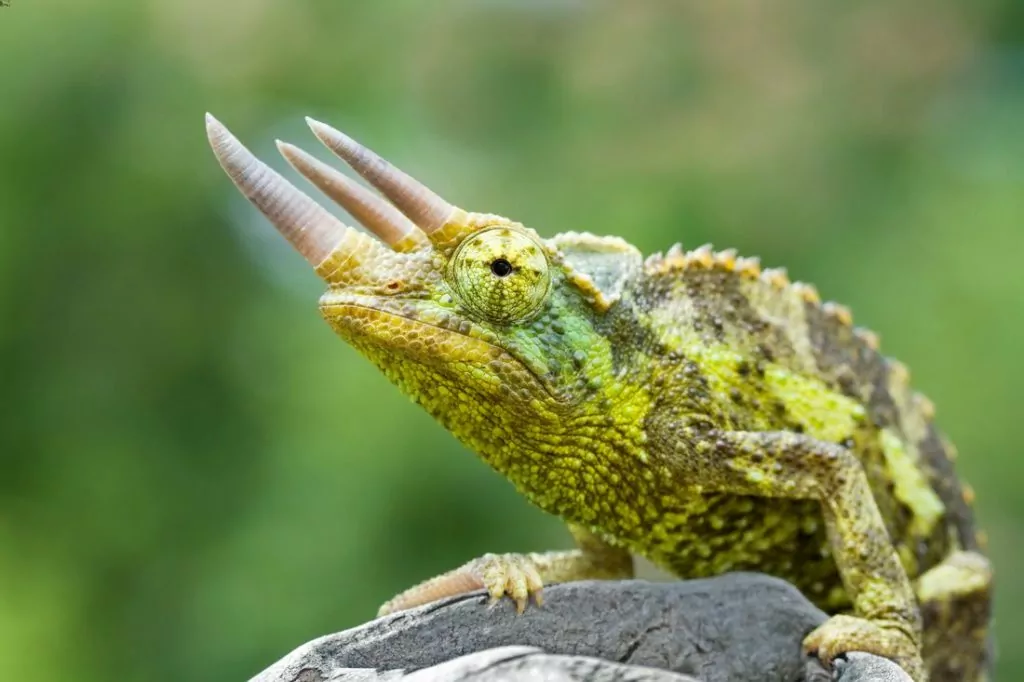
The ambient temperature within the enclosure should be between 70 degrees and 80 degrees Fahrenheit. For the gradient, you can create a basking area on one side of the enclosure and a cooler area on the other side.
The basking temperature needs to stay around 85 degrees Fahrenheit, and we suggest using a basking light or an incandescent light. To prevent serious burns to your lizard, place the light outside the enclosure.
Expert Tip: Nighttime temperatures can safely drop to 65 to 70 degrees Fahrenheit.
The lighting for the enclosure should come from a UV/UVB bulb. This type of light will provide a kind of substitute for the natural sunlight that a chameleon would normally get in the wild.
Lighting should be on a 12 hours on, 12 hours off schedule, and remember to replace the bulb every six months!
Humidity
Chameleons need a very humid environment, and the Jackson’s chameleon is no exception. A consistent humidity level of between 50 and 80 percent should be your goal.
Misting the enclosure at least twice a day will help maintain this level of humidity.
Also, having lots of plants within the enclosure really helps. Whether you use hand misting, a drip system or an automatic mister, keeping the plants damp and full of water droplets will secure both proper humidity and plenty of drinking water.
Expert Tip: Placing a hygrometer in the enclosure will help you monitor the humidity, and you will be able to make any necessary adjustments.
We highly recommend that you invest in a reliable and accurate one, even if it costs a few extra dollars. An inaccurate humidity reading is just as bad as no information at all!
Water
Your Jackson’s chameleon needs to stay well hydrated, so providing plenty of water in the form of droplets is going to be one of your ongoing tasks. However, we highly discourage placing a water bowl inside your chameleon’s enclosure.
Here’s why:
Firstly, your chameleon will probably go to the bathroom in the water bowl, and this can lead to a build up of bacteria.
Secondly, a Jackson’s chameleon, like all chameleons, has a sticky tongue. If your chameleon tries to drink from the water bowl, its tongue can get stuck to it. This can lead to serious damage to the tongue.
Lastly, these reptiles can easily drown in a bowl of water. Even if the bowl is shallow, it is not a good idea to have one in the enclosure.
Misting the enclosure and your chameleon’s body at least twice a day should give it enough water. Like we mentioned in the section above, misting can be done with a hand sprayer or with an automatic mister.
Food & Diet
Feeding your Jackson’s chameleon may not be as complicated as with other reptiles, but it’s going to be very important for you to feed your pet appropriate, nutritious food according to a regular schedule.
Jackson’s chameleons enjoy a variety of foods such as crickets, grasshoppers, mealworms, waxworms and super worms. In order to ensure that the insects you give your chameleon are as nutritious as possible, you’ll need to gut load them.
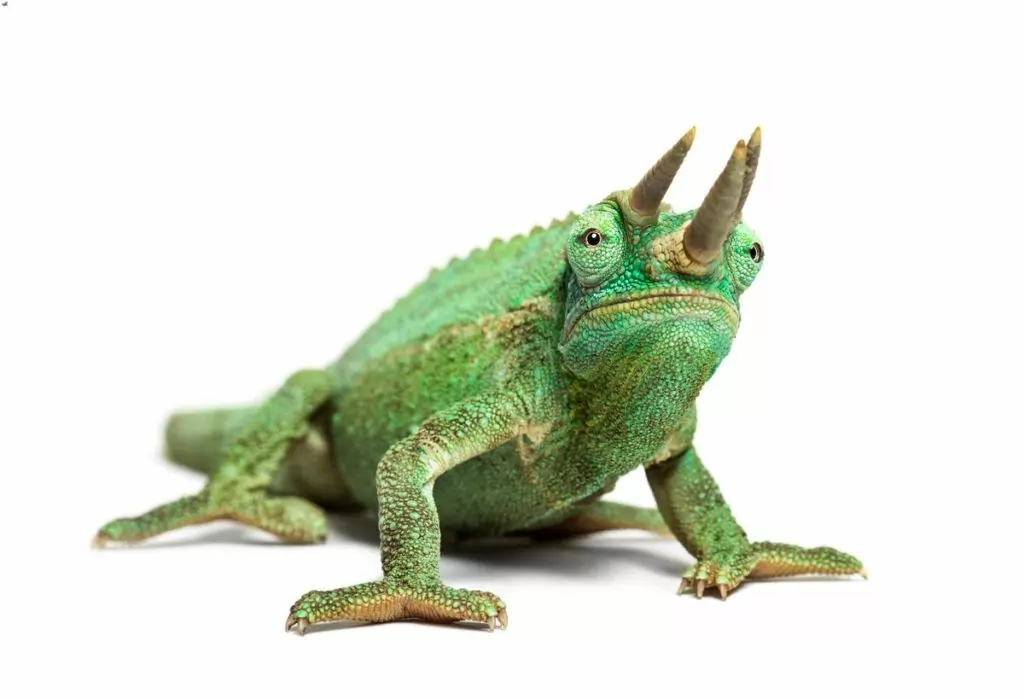
Gut loading means that when you feed nutritious food to the prey, this nutrition will pass to your chameleon. When you buy prey items, like crickets or mealworms from the store, they are usually not gut loaded enough. Before feeding your chameleon, you can give the prey things like fish flakes, sweet potato, carrots, oranges or even baby rice cereal.
Prey should also be dusted with a calcium and vitamin supplement powder. This dusting will help to prevent metabolic bone disease and other health related problems.
In terms of a feeding schedule, adult Jackson’s chameleons can be given five to seven insects at a time, and this can be done every other day. Since these reptiles like to hunt, you can give them live prey (this is a great source of enrichment too). After your chameleon has had its fill, make sure to take out any prey that wasn’t eaten.
Baby chameleons can be fed twice a day, and you should let them eat as much as they want. Juveniles can get 10-12 small crickets every day, and sub-adults should be fed 8-10 every day.
Expert Tip: The size of the prey is important, and you should never give your chameleon prey that is bigger than the space between your chameleon’s eyes.
Potential Health Issues
Jackson’s chameleons are known to be susceptible to a variety of health related issues. A strong relationship with a veterinarian who specializes in exotics is going to be very important if you own one of these reptiles.
Some of the most common health issues include:
Parasitic infections: Getting a regular fecal test on your chameleon is going to really help to stop an infection before it gets out of control. Fecal testing is especially important if you are bringing home a new chameleon because they are often loaded with parasites.
Respiratory infections: Jackson’s chameleons, like many other reptiles, are prone to respiratory infections caused by cold temperatures, insufficient humidity, improper diet, or even stress. If you notice that your chameleon isn’t eating, is lethargic, holds its mouth open for an extended period of time, or if it has mucosal discharge, take it to the vet right away. It might need a round of antibiotics.
Various skin issues: These are common and can come from improper shedding, scratches or fungal infections.
MBD: Metabolic bone disease, caused by a lack of UVB lighting and an improper diet, is preventable. This disease is very painful, so supplementing with UVB lighting and vitamins can help to prevent this disease.
It’s best to give your Jackson’s chameleon a daily once-over. Observe how it behaves, eats, and notice if it has any scratches or sores. By paying attention and providing them with the best care you can, you can significantly reduce the risk of them getting sick.
Behavior & Temperament
Jackson’s chameleons are very shy, and it takes almost nothing to stress them out. Overhandling and housing too many together are two of the main stress triggers you may encounter.
The best rule of thumb is to place only one chameleon per enclosure. We can’t stress it enough that males should not be housed together!
Even females can have a hard time being housed together. Just seeing another chameleon can cause tremendous amounts of stress, and this stress response can even happen if a chameleon sees itself in the walls of a glass enclosure.
A male and female can be placed fairly successfully in the same enclosure, but you are going to have to make sure that they each have plenty of room.
Expert Tip: As an arboreal creature, your Jackson’s chameleon will enjoy being high up in the enclosure, so it will definitely appreciate lots of things to climb and explore. This is not only a great source of enrichment, but it’s also a way for them to feel comfortable and stress-free.
Handling Tips
If you are looking for a reptile that reacts well to being handled, then the Jackson’s chameleon is definitely not for you. This chameleon does not like being handled at all, so if you do decide to care for one of these chameleons, plan to enjoy it through observation only.
If it becomes necessary to handle your Jackson’s chameleon, be very gentle with it and use slow motions. Never grab it forcefully or lift it by the tail. Lifting it by the tail can cause the tail to fall off, and the tail will not regenerate.
Overhandling can cause extreme stress or even injury. Your Jackson’s chameleon is happiest when allowed to roam its enclosure freely in peace and solitude.
Conclusion
Jackson’s chameleon care can be a very rewarding process for anyone who’s willing to put in some extra work. These gentle pet reptiles are easy to bond with, and very fun to observe.
Feel free to send over any questions that weren’t answered in this care sheet. We always enjoy connecting with our readers!

